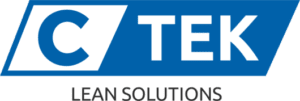Lean manufacturing vs. operational excellence
The business world is often filled with buzz words and trendy topics. Two phrases that you may be familiar with are “lean manufacturing” and “operational excellence.” Both are familiar terms, and you might be wondering how they are different, if at all. While both terms refer to a company’s efforts to strive for continual improvements, there are some key differences between the two to note. If you’re wondering how to distinguish one from the other, C Tek Lean Solutions has all the explanations you need.
What is Lean?
Lean manufacturing strives for continual improvement in business operations. Lean essentially aims to streamline the production cycle of a manufacturing or business process. The end goal of lean is to minimize process waste, remove bottlenecks, and minimize cycle times. In order to fully and effectively implement lean, businesses usually look for the seven main wastes:
- Transport
- Motion
- Inventory
- Waiting
- Defects
- Over-processing
- Over-production
Transport refers to the movement of products. Transportation occurs throughout the production and assembly line. Ultimately, transporting a product requires time and money. Reducing unnecessary transportation therefore saves on unnecessary expenses and product movement.
While transportation refers to moving products, motion is the movement of people. Motion includes all of an employee’s movements to determine whether they add value or produce waste. Sometimes technology is identified as a solution to reduce unnecessary movement.
Inventory refers to either a Finished Product (FP) or a Work in Progress (WIP). Storing items for perceived future production usually just takes up precious space on the production floor, which in turn results in superfluous products and can create avoidable expenses for the company.
Waiting is another area that generally causes waste in the production cycle. Waiting can mean waiting for a number of things in the cycle, including waiting for information, machinery, or items that were previously used in the process cycle or production line. Increased wait times translate to increased cycle time, which in turn creates waste.
Defects are the cost and time that goes into creating products that are designed outside of standard specifications. This can include the effort that goes into making the products and the necessary efforts required to correct the problems that they cause.
Over-processing is any added work in a production cycle that customers are not willing to pay for.
Over-production is a product that the customer is not willing to buy. Over-production creates unnecessary work and puts stress on the production process.
What is Operational Excellence?
Operational Excellence (Op-Ex) is the management philosophy of creating a workplace that strives for continual improvements and moves forward with the goal of meeting all performance standards and metrics. Operational Excellence entails aligning corporate activities with a single goal. Op-Ex encompasses both lean manufacturing and Six Sigma. Ultimately, the goal of Op-Ex is to align all corporate activities in a business with a single goal. All levels of the business must work together in unison in order to continuously improve. One key difference between Lean an Op-Ex is that while Lean emphasizes increasing product outflow and lowering costs, Op-Ex also incorporates other philosophies as well. Op-Ex also includes looking at ways to bring innovation to the product line and product development. It also looks for ways to increase value across the assembly and production line. In addition to lean, Op-Ex also incorporates some philosophies of Six Sigma, which is another method of reducing waste and improving quality and customer satisfaction in the manufacturing industry and across other business categories as well. While all are inter-related, there are some important differences that distinguish all three production models.
To find out more about Operational Excellence and Lean and learn how they differ, ask the experts at C Tek Lean Solutions today.
